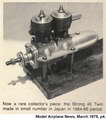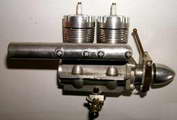|
|
For those of us who are much older than today's avid modelers, the long years of enjoying the "Foreign Notes" column and "Engine Reviews" in Model Airplane News so carefully written by P. G. F. Chinn have given us an historical perspective as well as a detailed analysis of hundreds of model engines. In the late 1980's when Chinn parted company with MAN over payment problems, a void was made that has only been partially filled by the modern engine analysis writers. The "warmth" and the personalness of Chinn commentary was unique. He ferreted out the news from all over the modeling world, keeping us up to date on the latest engines everywhere...for you see he had the contacts. Information flowed to him from everywhere.
One such "contact" was Akira Fujimuro of Tokyo who called Peter's attention to the rare STRONG 45, an alternate firing, inline glow twin designed and manufactured by Haruo Shimuzu also of Tokyo. Mr. Fujimuro was the owner/operator of "RevUp Models" and a former national Japanese U-control champion. Thus in the "Foreign Notes" column in the March, 1975 MAN, a picture of one of the STRONG 45 twins manufactured in the 1964-66 years appeared...one of a half dozen hand made by Shimuzu.
It, of course, was air-cooled and as noted an alternate firing, inline twin glow ignition, of twostroke-cycle configuration. Its three bypass ports had a single exhaust port on each cylinder. Deflectorless domed pistons, cast, bushed connecting rods, moved the balanced steel crankshaft. Twin disk-valve induction fed from a small single R/C carburetor mounted on the underside of the crankcase. The cast iron cylinders with very thin machined fins were attached to the sand cast aluminum crankcase by rectangular base flanges using studs and nuts. The cylinders are black. The machined aluminum, finless cylinder heads screw into the tops of the cylinders (like a Cox head) and have centered glow plugs. A single ball bearing supports the crankshaft in front with bronze in the rear and is in one piece. Black anodized case fins with separate black exhaust stacks, screwed on, contrast beautifully with the bright natural aluminum cylinder heads. The sand cast case with long side beam mounts, has an aluminum screw-in back plate and a cast, bolted on front case. On this case are two cast in round "extensions" to allow the piston rods full circle and in addition two undercase cooling and supporting fins. The prop driver is cast aluminum with raised "nubs", the prop washer is an aluminum one and the small prop nut steel. All in all a small very attractive model engine. A long, sort of "beehive" gas tank is an accessory attached to the back plate with a long bolt. The engine appears almost fragile compared to others, possibly because of much hand work and fitting in making it.
Norio Morita, one of the "Sony" sons and Japans top engine collector until his passing a few years ago in collaboration with Mr. Shimuzu and Mr. Fujimuro in 1975 designed and manufactured his "Kamikazi 40" (sic) inline twin engine. A close copy of the STRONG 45 engine, but more robustly built, featured an aluminum spinner nut and a long twin exhaust. It too utilized an under the case Enya R/C carburetor and modern manufacturing methods. First displayed at the Tokyo Model Show in October, 1974, it retailed at approximately $250 and was available in very limited numbers.
Both engines are sought by serious collectors commanding a large price when found and purchased. The "oddball" engines enhance the incentive for us all to seek them out for our edification and pleasure.
 Back to Model Engine News Home
Back to Model Engine News Home
Back to Janson Index Please submit all questions and comments to [email protected]

